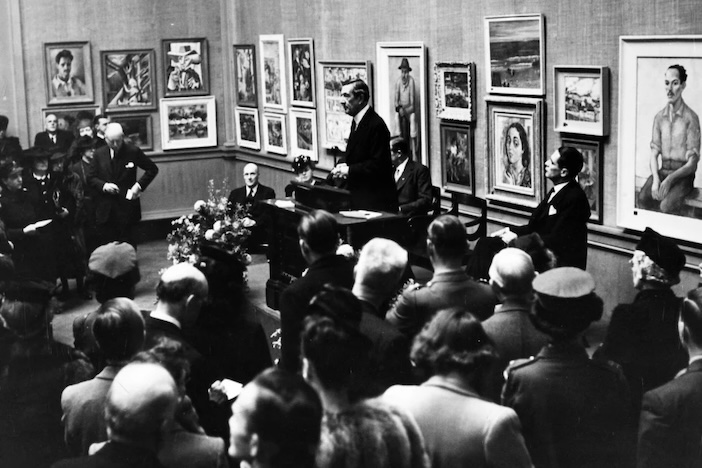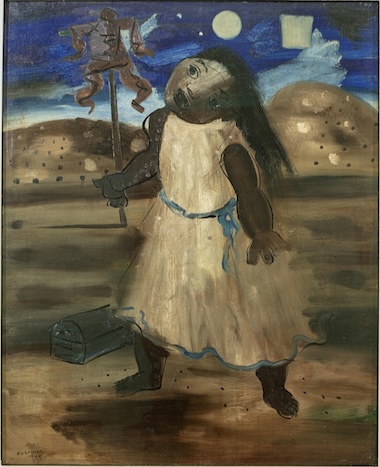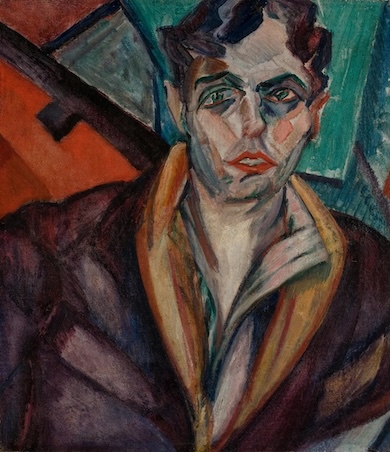In November 1944, an exhibition of 80 paintings and 86 works on paper by artists from Brazil was displayed at the Royal Academy, London. Aided by the Anglo-Brazilian Society it was a selling show of donated works and the money raised was generously given to the RAF Royal Benevolent Fund. It was the first and largest show of Brazilian Modernism in Britain, presenting art, architecture, literature, music and design.
Marking the 80th anniversary, the Royal Academy has a new show of works by Brazilian artists. ‘Brasil! Brasil! The Birth of Modernism’ salutes the memory of that first display, taking it further, exploring the works of ten artists, in figurative to abstract art, including four paintings by three artists who featured works in the original 1944 show.

The opening reception of the ‘Exhibition of Modern Brazilian Paintings’ at the Royal Academy of Arts, 1944 (photo courtesy of the RA)
Brazil became a republic in 1889, emerging after centuries of Portuguese colonisation. This was a moment for Brazil to affirm its new identity. Brazilian artists enjoyed new freedoms. Many travelled to Europe, to study art. Tasala do Amaral studied at the Academie Julien in Paris, noted for accepting female painters, returning to Sao Paulo in 1922; Roberto Burle Marx, a landscape architect and artist, returned in 1930 from Berlin; and Anita Malfatti, studying in Paris under the mentorship of Maurice Denis, returned in 1928.
Their art, like others in this group of ten, were initially influenced by their experiences in Europe but the essence of their work is inspired by their homeland, Brazil. It is visible in the colour and vibrancy of the compositions; in the landscapes, the buildings, and the portraits of people, all stimulated by their experiences.

Candido Portinari, The Scarecrow, 1940. Mercer Art Gallery, Harrogate. (Photo © Gary Lawson Media. © Portinari, Candido / © DACS 2024)
This show gives space to the work of ten artists active from 1910 through to the 1970s. It opens with a stunning piece, The Scarecrow, painted in 1940 by Candido Portinari, on loan from the Mercer Gallery in Harrogate. The son of Italian immigrants, Portinari grew up on a coffee plantation in Brazil, and sought to create a national identity in his work, painting local people, recording their often harsh lives. From a poor family, he won a scholarship and travelled for two years through France, Spain, Italy and England, learning from Old Masters’ paintings, as well as contemporary art.
Another work, Lake, from 1928, by the leading Latin-American Modernist Tarsila do Amaral, has been chosen as the visual work to promote the show. It illustrates a rich-blue lake surrounded by mountains, lush green palm trees and sugary pink favelas. Amaral desired to be ‘the painter of my country’, and the composition gives a sense of place and time, the essence of Brazilian Modernism, in its fusion of European art and Brazilian landscape and tradition.
Roberto Burle Marx, born in São Paulo in 1909, is one of the chosen artists who was an architect and garden designer, who used art to visualise his designs. At 18, Burle Marx moved to Berlin to study at art school, and regularly visited the botanical gardens in Berlin, recognising in them Brazil’s indigenous hothouse plants. This interest later led him to seek protection of the Brazilian rain forests, and the foundation of an extensive collection of over 3,600 tropical plants. He returned to Brazil in 1930.
Burle Marx’s garden landscape designs are noted worldwide. An abstract design of organically shaped paths and plant bedding, painted in oils, was translated into a plan for the roof gardens of the Ministry of Education and Public Health in Rio de Janeiro in 1938. (This work is on show in ‘Gardens of the Future: Designing with Nature’ at the Nieuwe Institut in Rotterdam, a centre dedicated to architecture and design.) His work expressed avant-garde design in the 1930s and led to projects with Brazilian-Portuguese architect Oscar Niemeyer, a key figure of Brazilian modern architecture, and in 1960 Burle Marx was involved in the landscape design of Brasil’s capital, Brasilia.

Portrait of Oswald (1925) by Anita Malfatti
Burle Marx is an exemplar of the profiles of the artists in the Royal Academy exhibition. Standout works include Archer (1925) by Vicente do Rego Monteiro, the unusual abstract Untitled (1950) by Italian-born Alfredo Volpi and Portrait of Oswald (1925) by Anita Malfatti. Indeed, Malfatti is thought to be the first artist to introduce European and American art to Brazil. It is a fascinating group with contributions by Laser Segall, Flavio de Carvalho, Djanira da Motta e Silva and Geraldo de Barros. Rubem Valentim, the youngest of this engaging group of ten, who initially trained as a dentist before becoming a painter and sculptor, also features, specifically linking Afro-Brazilian culture to modernism.
Some critics have expressed their concerns that the Royal Academy has chosen artists from Brazil who studied in Europe, that this somehow doesn’t reflect Brazilian art. But that argument is a fallacy when you consider that so many artists from USA, Europe and Russia, travelled to Paris, both the wealthy and poorer students, to study at their academies, or browse art galleries showing contemporary art, because Paris prior to the second world war, was the centre of the art world. But, whatever one’s opinions, it will be for visitors to ‘Brasil! Brasil! The Birth of Modernism’ to decide whether they like what they see. Judging by attendances to date, this is an exhibition that is drawing in the crowds.
Brasil! Brasil! The Birth of Modernism runs at the Royal Academy of Arts until 21 April 2025. Open Tuesday to Sunday. For more information, please visit www.royalacademy.org.uk.
Roberto Burle Marx in Gardens of the Future: Designing with Nature is on at the Nieuwe Institut until 12 April 2025. For more information, please visit www.nieuweinstituut.nl.
Header image: Detail from Lake (1928) by Tarsila do Amaral




